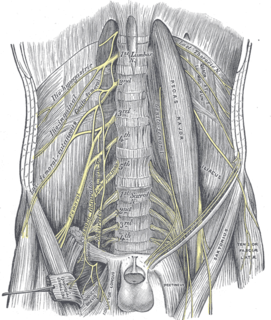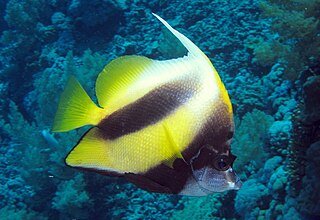
The quadriceps femoris muscle is a large muscle group that includes the four prevailing muscles on the front of the thigh. It is the great extensor muscle of the knee, forming a large fleshy mass which covers the front and sides of the femur. The name derives from Latin four-headed muscle of the femur.

The Orinoco crocodile is a critically endangered crocodile. Its population is very small, and it can only be found in freshwater environments in Colombia and Venezuela. Extensively hunted for their skins in the 19th and 20th centuries, it is one of the most endangered species of crocodiles. It is a very large species of crocodilian; males have been reported up to 6.8 m in the past, but such sizes do not exist today, 5.2 m being a more widely accepted maximum size. A large male today may attain 4.1 m in length and can weigh 380 kg (840 lb), while females are substantially smaller with the largest likely to weigh around 225 kg (496 lb). Sexual dimorphism is not as profound as in other crocodilian species. The coloration is light even in adults.

The femoral nerve is a nerve in the thigh that supplies skin on the upper thigh and inner leg, and the muscles that extend the knee.

The intermediate nerve, nervus intermedius, nerve of Wrisberg or Glossopalatine nerve, is the part of the facial nerve located between the motor component of the facial nerve and the vestibulocochlear nerve. It contains the sensory and parasympathetic fibers of the facial nerve. Upon reaching the facial canal, it joins with the motor root of the facial nerve at the geniculate ganglion. Alex Alfieri postulates, that the intermediate nerve should be considered as a separate cranial nerve and not a part of the facial nerve.
Geniculate ganglionitis or geniculate neuralgia (GN), also called nervus intermedius neuralgia, Ramsay Hunt syndrome, or Hunt's neuralgia, is a rare disorder characterized by severe paroxysmal neuralgic pain deep in the ear, that may spread to the ear canal, outer ear, mastoid or eye regions. GN may also occur in combination with trigeminal or glossopharyngeal neuralgia.

The Red Sea bannerfish is a species of marine ray-finned fish, a butterflyfish from the family Chaetodontidae. It is found in the western Indian Ocean. It has been recorded as an intrioduced species off Florida and as a Lessepsian migrant in the eastern Mediterranean Sea off Turkey.

Hayman's dwarf epauletted fruit bat or Hayman's epauletted fruit bat is a species of megabat in the family Pteropodidae. It is found in Angola and Democratic Republic of the Congo. Its natural habitats are subtropical or tropical moist lowland forest and moist savanna. It is threatened by habitat loss.

Andersen's flying fox is a species of flying fox in the family Pteropodidae found in south Burma and west Thailand. Although it is hunted for both food and as a pest, it is not known if this has a significant impact on the species. It has been seen roosting in tall, well-established trees in urban areas and will fly several kilometres to eat wild and cultivated fruits. The species was named after Knud Christian Andersen. It was last recorded in Thailand in 1970 and, presumably, there is still a small viable population in Myanmar.

Gloydius intermedius is a venomous pitviper species endemic to northern Asia. Three subspecies are currently recognized, including the nominate subspecies described here.

Adenanthos barbiger, the hairy jugflower or hairy glandflower, is a species of shrub in the family Proteaceae. It is endemic to the south-west of Western Australia. It usually grows to 1 metre high, and has bright red flowers that appear mostly between August and December. The species was first formally described in 1839 by English botanist John Lindley in A sketch of the vegetation of the Swan River colony.
Parajapyx is a genus of diplurans in the family Parajapygidae.
Amblyseius intermedius is a species of mite in the family Phytoseiidae.
Staphylococcus intermedius is a Gram-positive, catalase positive member of the bacterial genus Staphylococcus consisting of clustered cocci. Strains of this species were originally isolated from the anterior nares of pigeons, dogs, cats, mink, and horses. Many of the isolated strains show coagulase activity. Clinical tests for detection of methicillin-resistant S. aureus may produce false positives by detecting S. intermedius, as this species shares some phenotypic traits with methicillin-resistant S. aureus strains. It has been theorized that S. intermedius has previously been misidentified as S. aureus in human dog bite wound infections, which is why molecular technologies such as MALDI-TOF and PCR are preferred in modern veterinary clinical microbiology laboratories for their more accurate identifications over biochemical tests. S. intermedius is largely phenotypically indiscriminate from Staphylococcus pseudintermedius and Staphylococcus delphini, and therefore the three organisms are considered to be included in the more general 'Staphylococcus intermedius group'.

Tensor vastus intermedius is a muscle in the anterior compartment of thigh. It lies between the vastus intermedius and the vastus lateralis. The structure has been previously reported but has not been described nor illustrated in any textbook. The term tensor vastus intermedius was given by Grob et al. in 2016.
Parajapyx emeryanus is a species of two-pronged bristletail in the family Parajapygidae.
Parajapyx isabellae is a species of two-pronged bristletail in the family Parajapygidae. It is found in Africa, Europe & Northern Asia, North America, Oceania, South America, and Southern Asia.
Parajapyx pauliani is a species of two-pronged bristletail in the family Parajapygidae.
Parajapyx unidentatus is a species of two-pronged bristletail in the family Parajapygidae. It is found in North America.
Australentulus intermedius is a species of proturan in the family Acerentomidae. It is found in Australia.
Tasmanentulus intermedius is a species of proturan in the family Acerentomidae. It is found in Australia.









